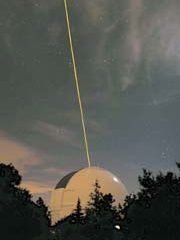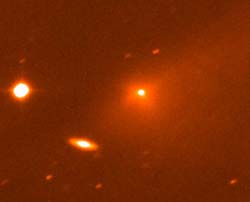Physics and Astronomy
This area deals with the fundamental laws and building blocks of nature and how they interact, the properties and the behavior of matter, and research into space and time and their structures.
innovations-report provides in-depth reports and articles on subjects such as astrophysics, laser technologies, nuclear, quantum, particle and solid-state physics, nanotechnologies, planetary research and findings (Mars, Venus) and developments related to the Hubble Telescope.

Astrophysicists use laser guide star adaptive optics
For the first time, scientists from UC Berkeley and Lawrence Livermore, in conjunction with astrophysicists from the California Institute of Technology, UC Santa Cruz, the National Science Foundation’s Center for Adaptive Optics and UC’s Lick Observatory, have observed that distant larger stars formed in flattened accretion disks just like the sun.
Using the laser guide star adaptive optics system created by LLNL scientists, the team was able to determine that some of the relativel

Astronomers find nearest, youngest star with dusty debris disk. But are there planets?
Astronomers at the University of California, Berkeley, have discovered the nearest and youngest star with a visible disk of dust that may be a nursery for planets.
The dim red dwarf star is a mere 33 light years away, close enough that the Hubble Space Telescope or ground-based telescopes with adaptive optics to sharpen the image should be able to see whether the dust disk contains clumps of matter that might turn into planets.
“Circumstellar disks are signposts for planet formati

Large Diamonds Made From Gas Are Hardest Yet
Producing a material that is harder than natural diamond has been a goal of materials science for decades. Now a group headed by scientists at the Carnegie Institution’s Geophysical Laboratory in Washington, D.C., has produced gemsized diamonds that are harder than any other crystals, available at a rate that is up to 100 times faster than other methods used to date. The process opens up an entirely new way of producing diamond crystals for electronics, cutting tools and other industrial applica

A new step in spintronics
’Organic spin valves’ shown feasible for new electronic devices
University of Utah physicists have taken an important step toward a new generation of faster, cheaper computers and electronics by building the first “organic spin valves” – electrical switches that integrate two emerging fields of technology: organic semiconductor electronics and spin electronics, or spintronics.
In a study published Feb. 26 in the journal Nature, the researchers report they used a se

Once a myth, now an object of study
On 26 February, Rosetta will be setting off on its long journey through our solar system to meet up with Comet Churyumov-Gerasimenko. It will take the European Space Agency (ESA) space probe ten years to reach its destination.
The comet, which moves in an elliptical orbit around the Sun, will at rendezvous be some 675 million kilometres from the Sun, near the point in its orbit farthest from the Sun. The meeting point was not chosen at random: at this point the comet is still barely active,

Lehigh researchers hone radiation source for THz devices
Potential applications in medicine, remote sensing, imaging and satellite communications
A world that consumes information in gigabytes may one day find terahertz-sized solutions for some of its most pressing problems.
While one gigabyte is equal to one billion (109) bytes of information, a terahertz (THz) is a unit of electromagnetic-wave frequency equivalent to one trillion (1012) hertz, with one hertz equaling one cycle per second.
Terahertz (THz) frequencies, r